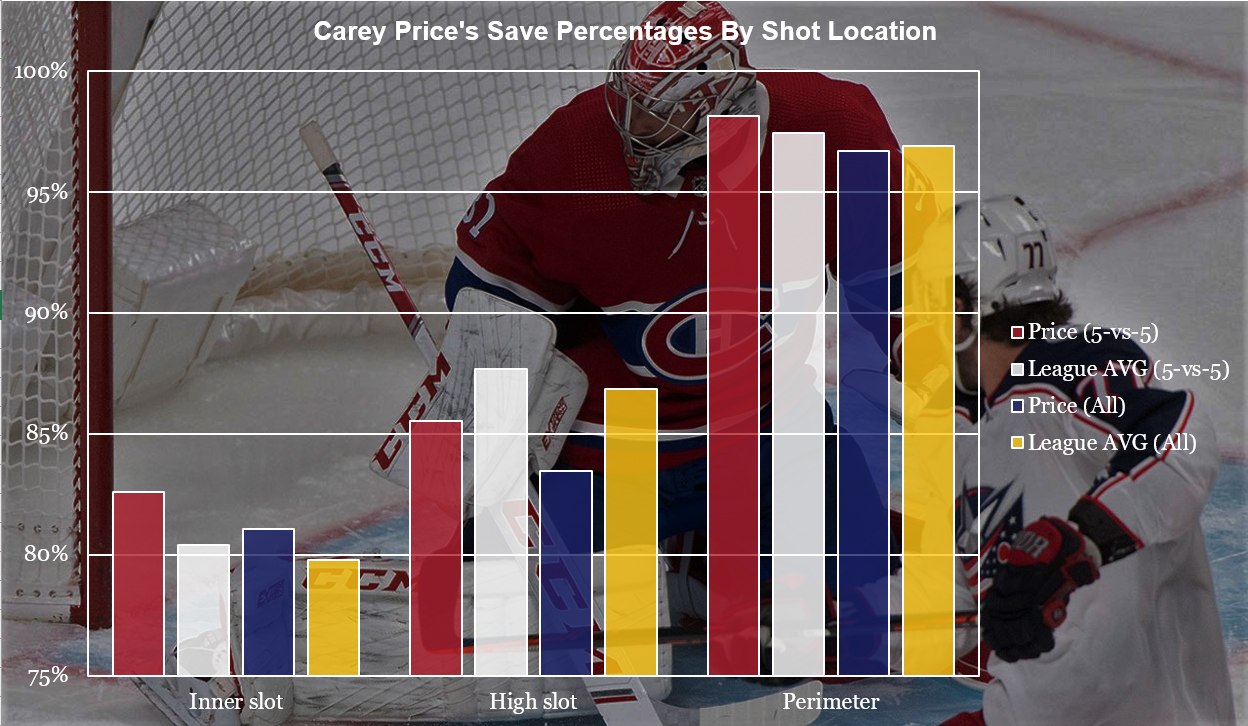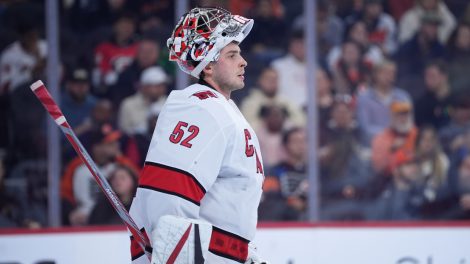In the midst of a five-game losing streak, mostly against teams they have no business losing to, the Montreal Canadiens are in danger of completely erasing a promising start to the season.
An absolute beatdown at the hands of the rival Boston Bruins and a blown 4-0 lead against one of the worst teams in the league in the New York Rangers has put the focus squarely on Carey Price. And, looking at just those two games, it’s hard to fault anyone for thinking that.
However, heading into those two games, it would have been incredibly unreasonable to blame Price for any of the Canadiens’ struggles this season. He was saving them a half goal per game better than expectations based on the shots they were giving up. With that said, his past two starts have taken a lot of the shine off of his season-long numbers.
So what has plagued Price and kept him from the performance level that’s expected of a player making over $10 million per season?

At 5-on-5 and in all situations, the struggles are in the same area. Price has remained above league average by a significant margin on the most dangerous shots goalies face, but he’s been getting torn up in the high slot area and that isn’t new to this season.
Things shook out about the same last season. And looking back to Price’s worst season in 2017-18, he struggled everywhere, but the high slot was the biggest area of trouble.
Goaltending is always tough to evaluate because there are so many factors at play, and there just isn’t nearly as much data to work with as there is for skaters. In the end, most of what a goaltender deals with is out of their control.
One area they can control is their rebounds, and Price ranks highly in rebound control at both even strength and in all situations. Sixty-one per cent of the shots Price faces don’t produce a rebound and when he does produce one, he’s not sending it into his own weak area very often. On average, goalies sent rebounds into the high slot on 5.6 per cent of the shots they can’t control, while Price’s end up there just 3.6 per cent of the time. That’s good in that Price isn’t creating more chances from the area he’s struggling from, but there’s more to just giving up rebounds.
Price’s rebounds end up in the inner slot area at about the league average rate — around 17 per cent of the rebounds he gives up end there — and the Canadiens are a below average team at recovering those rebounds. On average in the NHL, 60.4 per cent of rebounds in the inner slot are recovered by the defending team, while the Canadiens recover just 55.9 per cent of them.
So the Canadiens are not a great team at controlling the area in front of their goaltender, but Price has remained above average there anyway. Part of the reason for that also factors into why he’s been weaker from further out: he’s playing deeper in the net.
[snippet ID=3322139]
I wanted to be sure I wasn’t out to lunch, so I spoke to fellow Sportsnet contributor and goalie expert Paul Campbell, and based on his work on Price he also believes Price has played considerably deeper in recent seasons, and we agreed on the reasons for that change.
Age is a factor of course. As goalies get older they’ll lose some speed and explosiveness in their lateral movement, and you can add Price’s history of lower body injuries into that; not that we know by any means those have slowed him down, but it’s a reasonable assumption that there’s some attrition involved.
But the bigger issue by far is that the Canadiens are one of the worst pass defending teams in the league.
Last season the Canadiens not only allowed amongst the most passes to the slot in the league, but they were also the worst team at preventing attempted slot passes from being completed. Contrast that with their last opponent in Boston, who were the league’s best.
To be fair to the Canadiens, they’ve made serious strides this season. They’re inching closer to league average while ranked 22nd in that area, but a lot of that improvement has come in trying to protect Keith Kinkaid, while Price is left to deal with some sloppier play.
[snippet]
Kinkaid faces fewer passes to the slot and fewer inner slot shots than Price does on a per minute basis. That strategy makes sense, but Price has changed his game over time to adapt to the poor pass defence in front of him. Playing deeper gives him a better chance at getting across for those one-timer plays, but the trade-off is he’ll get burnt more often on shots from slightly further out.
The Canadiens are a high-flying team especially at 5-on-5, where they lead the league in inner slot shots per 60 minutes at 7.67, but also give up the fifth-most in their own end. The issues defensively aren’t just in the inner slot either.
Of all the shots the Canadiens give up from the slot, 12.3 per cent are one-timers, which is the fifth-worst mark in the league; 13.9 per cent of their inner slot shots allowed have been one-timers, the second-worst mark in the league; and 37.3 per cent of the shot attempts they give up are from the slot, the fifth-worst mark in the league. The Canadiens also give up 38.7 defensive zone turnovers every 60 minutes, better than only the Ottawa Senators. The Canadiens allow 2.14 deflections on net every 60 minutes, the third-worst mark in the league.
All of these things make life much harder on their goaltenders, and if Price was 25 instead of 32 it may not be as big of a deal considering the offensive work the team has put in. But when Price has off nights he’s going to get lit up under this defensive structure. That doesn’t mean Price shouldn’t shoulder blame for having off nights, but all players have them.
Montreal is extremely fun to watch, but high-flying offence and lottery team defence will keep them in bubble team territory all season long, especially when the offence is by committee.
[relatedlinks]







